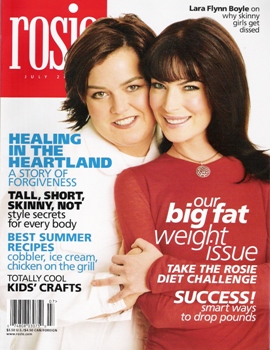
That story ran almost four years after New York Times public editor Daniel Okrent eviscerated his paper's handling of the same-sex marriage issue. I'll repost a few paragraphs:
But for those who also believe the news pages cannot retain their credibility unless all aspects of an issue are subject to robust examination, it's disappointing to see The Times present the social and cultural aspects of same-sex marriage in a tone that approaches cheerleading. So far this year, front-page headlines have told me that ''For Children of Gays, Marriage Brings Joy'' (March 19); that the family of ''Two Fathers, With One Happy to Stay at Home'' (Jan. 12) is a new archetype; and that ''Gay Couples Seek Unions in God's Eyes'' (Jan. 30). I've learned where gay couples go to celebrate their marriages; I've met gay couples picking out bridal dresses; I've been introduced to couples who have been together for decades and have now sanctified their vows in Canada, couples who have successfully integrated the world of competitive ballroom dancing, couples whose lives are the platonic model of suburban stability.
Every one of these articles was perfectly legitimate. Cumulatively, though, they would make a very effective ad campaign for the gay marriage cause. You wouldn't even need the articles: run the headlines over the invariably sunny pictures of invariably happy people that ran with most of these pieces, and you'd have the makings of a life insurance commercial.
It goes one from there. Anyway, I thought of Okrent's words when I read a piece in the Times yesterday that presented, as he put it, the "social and cultural aspects of same-sex marriage in a tone that approaches cheerleading." Apparently the Times doesn't care to look at the same-sex marriage issue in any different way. The article, by Ariel Kaminer, is about how the gay family cruises run by Rosie and Kelli O'Donnell handle on-board entertainment. Here's a sample:

Wearing T-shirts and Crocs, straining at their waistbands and beginning to contemplate middle age, they might have passed for the guests on any other cruise. If, that is, they were not quite so wholesome, so relentlessly focused on being good parents and raising happy kids. At the dock, the ship seemed to serve as a kind of reverse quarantine, a metal container moored off 12th Avenue to prevent the passengers' expansive child-friendly values from wiping out New York's social ecology.
That's how the whole article goes, written as if the experience on the cruise is nothing but lollipops and rainbows. I have never seen so many positive words per paragraph since I received the Ricky Schroeder Fan Club newsletter. (Feel free to make fun of me, but Silver Spoons was good television.) Seriously -- after talking about how everyone gets into the spirit of helping and how this cruise is the only place in the world where nobody is judged, the reporter quotes Seth Rudetsky, the musical director for the cruise's entertainment:
Mr. Rudetsky was more emphatic. "It's the greatest entertainment in the world," he said. Add in the cruise's inclusive spirit, and, he said: "It's like, what if the world were perfect? And the taste is just so amazing. In part because it's my taste."
It would be one thing if Purity Balls were covered this way. But if they're not -- they're not and neither should they be -- why the double standard? Heavy-hitting coverage and a critical eye are good things, not bad things -- for everyone. It's okay to discuss potential downsides to gay marriage, as Okrent wrote in his 2004 piece. He noted that other papers had run stories that gave more rounded coverage to the effects of same-sex marriage. Here's how he ended that piece:
On a topic that has produced one of the defining debates of our time, Times editors have failed to provide the three-dimensional perspective balanced journalism requires. This has not occurred because of management fiat, but because getting outside one's own value system takes a great deal of self-questioning
What's happened in the last four years at the Times? Why is coverage still so one-dimensional? Is it the same fear that the New York Times value system can't withstand the scrutiny? What can be done to give us better, more complex, more diverse, coverage of same-sex marriage?
